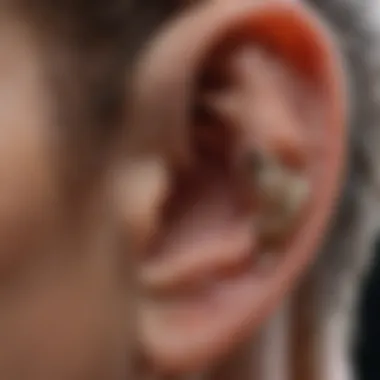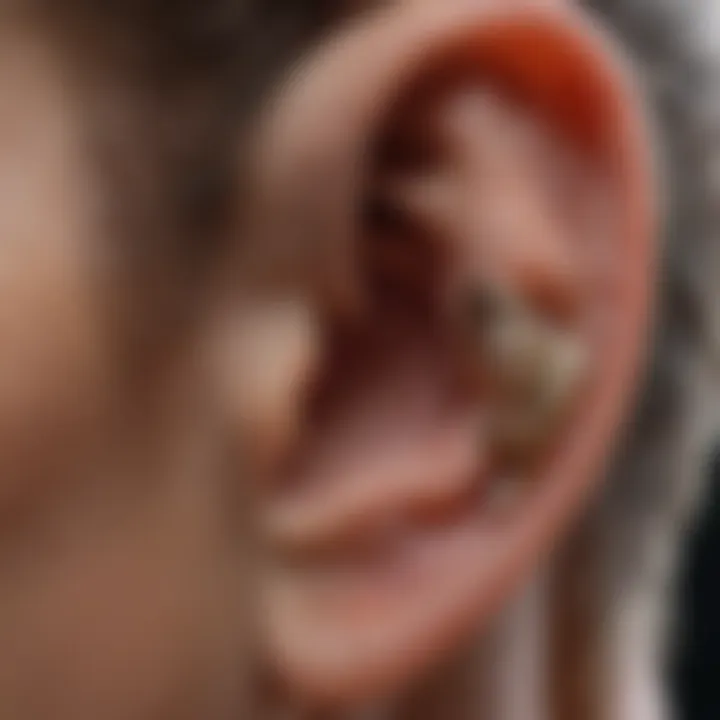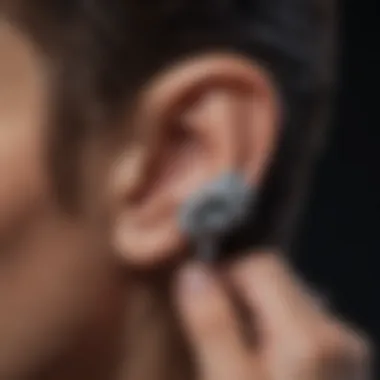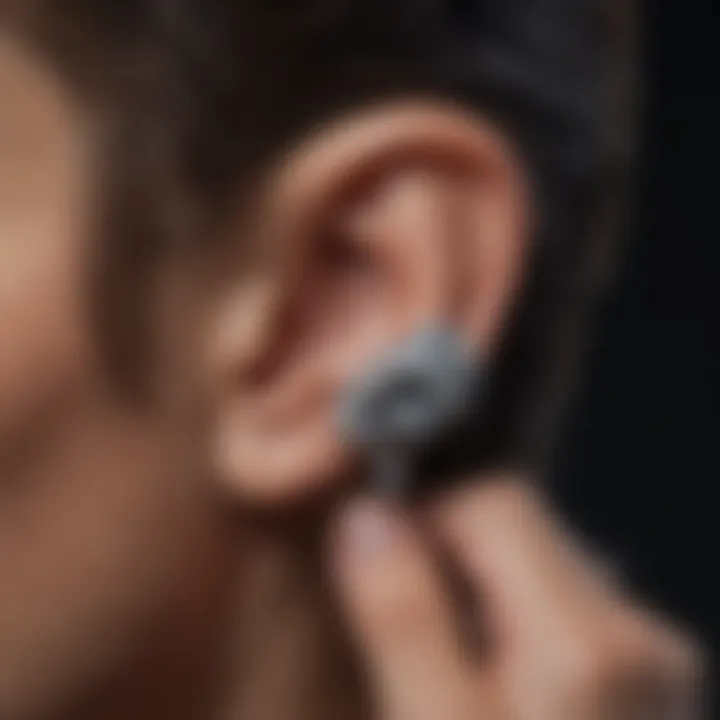Advancements of MRI in Ear Health Diagnosis


Intro
Magnetic Resonance Imaging (MRI) has emerged as a critical tool in the field of ear health, facilitating the diagnosis of various conditions that may affect the auditory system. Its ability to produce detailed images without the use of ionizing radiation makes it a preferred choice among healthcare professionals. This article examines the clinical significance of MRI in diagnosing ear-related issues, highlighting not only its technical advantages but also the specific conditions it can effectively evaluate. The integration of MRI into ear health management not only enhances diagnostic accuracy but also influences treatment strategies.
Article Overview
Summary of Key Findings
The investigation into MRI applications has revealed several essential insights:
- MRI provides superior soft tissue contrast, making it ideal for visualizing structures in and around the ear.
- Conditions such as cholesteatoma, vestibular schwannoma, and otitis media can be adequately assessed using this imaging technique.
- MRI avoids the risks associated with radiation exposure, thus being safer for repeated use in patients.
Research Objectives
The objectives of this research include:
- Understanding the anatomical details that MRI can reveal in ear health.
- Comparing MRI with other imaging methods like CT scans.
- Analyzing how the results from MRI influence treatment planning for patients.
Key Results and Discussions
Main Findings
Recent studies have shown that MRI scans can detect a range of ear disorders effectively. Specifically, the high-resolution images allow clinicians to evaluate abnormalities in:
- Auditory canals
- Middle ear structures
- Inner ear structures
It has been noted that conditions such as:
- Cholesteatoma, characterized by abnormal skin growth in the middle ear
- Acoustic neuroma, a benign tumor on the vestibulocochlear nerve
- Inner ear inflammation, often observed in cases of labyrinthitis
are often better visualized with MRI than with other imaging techniques.
Implications of Findings
The implications of these findings are noteworthy:
- Improved diagnosis leads to timely and targeted interventions, reducing the potential for complications related to untreated ear conditions.
- Enhanced imaging facilitates better surgical planning when necessary.
- Patients demonstrate heightened satisfaction due to clearer diagnostic pathways and reduced procedural uncertainties.
"MRI's ability to visualize soft tissues provides the clearest assessment of many ear-related conditions, fundamentally altering approaches to diagnosis and treatment planning."
Foreword to MRI and Ear Health
Understanding the intersection of Magnetic Resonance Imaging (MRI) and ear health is crucial for several reasons. MRI serves as a potent diagnostic tool that enhances the ability to evaluate various conditions affecting the ear. This section sets the stage for appreciating the advancements MRI offers in examining ear-related issues.
MRI technology provides non-invasive imaging that yields high-resolution pictures. Unlike Computed Tomography (CT) and X-rays, MRI shows detailed images of soft tissues, making it ideal for diagnosing ear disorders. The ability to visualize structures such as the cochlea, vestibule, and surrounding tissues provides a clearer picture of underlying problems. Clinicians can thus formulate better treatment plans based on accurate imaging.
In clinical practice, ear health holds significant importance. Ear disorders can affect hearing and balance, impacting quality of life. Timely and accurate diagnostics are critical. MRI plays an essential role here. By understanding how MRI technology works, one can appreciate its contributions to ear health diagnosis and treatment. Moreover, it enhances collaborative efforts between audiologists and radiologists. This partnership fosters holistic patient care as they work together to interpret results and establish appropriate interventions.
"MRI is not just a scanning tool; it reshapes the approach to ear health management and elevates the standard of patient care."
Ultimately, the discussion surrounding MRI applications in ear health brings attention to a sophisticated approach to diagnosing complex ear disorders, maximizing treatment effectiveness, and improving patient outcomes.
Overview of MRI Technology
MRI technology employs a powerful magnetic field, radio waves, and a computer to produce detailed internal images of the body. The basis of how it works lies in the alignment of hydrogen atoms in the body. When exposed to the magnetic field, these atoms align. The radio waves then disrupt this alignment, eliciting signals that the system captures. These signals are subsequently converted into images representing the internal anatomy. The high contrast of soft tissues compared to other imaging techniques is particularly advantageous for ear health assessments.
Key features of MRI technology include:
- Non-invasive procedure: No ionizing radiation is used, making it safer for patients.
- High-resolution images: Provides intricate details of soft tissue structures.
- Versatility: Capable of evaluating various conditions affecting the ear.
Significance of Ear Health in Clinical Practice
The significance of ear health cannot be overstated. Disorders of the ear can lead to severe repercussions, including loss of hearing, vertigo, and communication difficulties. These conditions often require precise diagnostics to inform treatment. Conditions like sudden sensorineural hearing loss and vestibular schwannomas can have abrupt presentations and require immediate attention.
Furthermore, the clinical implications of untreated ear disorders can extend beyond physical symptoms. The mental and emotional toll can be profound, affecting social interactions, work performance, and overall quality of life. Therefore, integrating advanced imaging technologies such as MRI into clinical practice is vital for prompt and accurate diagnosis, leading to better patient management and outcomes.
In summary, connecting MRI technology with ear health illuminates a pathway for improved diagnosis and treatment, underscoring the critical role of timely interventions in enhancing patient well-being.


Understanding MRI in Ear Examination
Magnetic Resonance Imaging (MRI) serves as a vital tool in analyzing ear health. Understanding how MRI works in ear examination leads to better diagnostic outcomes. This section aims to articulate key components of MRI in ear health, its effectiveness, and considerations surrounding its use.
How MRI Works
MRI employs powerful magnets and radio waves to produce detailed images of the internal structures of the body, including the ear. Unlike X-rays or CT scans, MRI does not utilize ionizing radiation. Instead, it generates images based on the behavior of hydrogen atoms when subjected to a magnetic field. When a person enters the MRI machine, these atoms align with the magnetic field. Pulses of radiofrequency are then sent through the body, nudging the hydrogen atoms out of their equilibrium state. As they return to their aligned position, they emit signals that the MRI machine translates into images.
This imaging method is particularly advantageous for visualizing soft tissues, making it well-suited for examining ear structures. Conditions like sudden sensorineural hearing loss or vestibular schwannoma benefit from the capabilities of MRI to highlight subtle changes that may not be as apparent in other imaging methods.
Differences Between MRI and Other Imaging Techniques
When assessing ear conditions, it is important to compare MRI to alternative imaging techniques such as CT scans and traditional X-rays. Here are some critical differences:
- Radiation Exposure: Unlike CT scans and X-rays, which use ionizing radiation, MRI is safer as it relies on magnetic fields and radio waves.
- Image Detail for Soft Tissues: MRI produces higher resolution images of soft tissues compared to CT scans. This makes it invaluable for identifying conditions affecting the ear, where soft tissue evaluation is essential.
- Diagnosis of Complex Conditions: MRI excels in diagnosing complicated ear conditions like cholesteatoma and vestibular disorders. These abnormalities can be challenging to visualize with other modalities.
- Functional Imaging Capabilities: Functional MRI can assess blood flow and neural activity, adding another layer of diagnostic information, particularly useful for conditions impacting the brain's auditory pathways.
Conditions Evaluated by MRI in the Ear
MRI plays a crucial role in assessing various conditions related to ear health. This functionality is vital because conditions affecting the ear often present unique complexities. Understanding the anatomy through detailed imaging can lead to quicker, more accurate diagnoses. MRI provides a non-invasive technique to visualize soft tissues, making it particularly effective for identifying abnormalities that other imaging methods may miss. The following sections explore specific ear disorders recognized by MRI, emphasizing their significance in clinical practice.
Inner Ear Disorders
Sudden Sensorineural Hearing Loss
Sudden Sensorineural Hearing Loss (SSNHL) represents a significant clinical concern as it causes rapid hearing loss. This condition can affect one or both ears, impacting a patient’s way of life. The immediate response and investigation are critical due to the potential for treatment efficacy. MRI is beneficial in identifying underlying causes, such as labyrinthitis or acoustic neuromas, which can directly correlate with SSNHL.
The key characteristic of SSNHL is its sudden onset, often occurring without warning. MRI is especially useful in this context, as it can discern between various etiologies contributing to this phenomenon. An essential aspect to highlight is that early MRI evaluation can delineate between those patients who may have reversible hearing loss versus those with permanent damage. The primary advantage here is the capability to guide immediate therapeutic decisions.
Vestibular Schwannoma
Vestibular Schwannoma, also known as acoustic neuroma, is a benign tumor that develops on the vestibulocochlear nerve. The implications of this condition can be profound as it can lead to hearing loss, tinnitus, and balance issues. MRI is the imaging modality of choice for diagnosing this disorder due to its high sensitivity in identifying the tumor, even in its early stages.
The unique feature of Vestibular Schwannoma is its capacity to grow slowly. This slow progression often results in delayed diagnosis, increasing the importance of MRI in management. The benefit of MRI in this context lies in its ability to provide detailed images that facilitate monitoring the tumor's progression, as well as planning for potential surgical intervention if necessary.
Middle Ear Pathologies
Ossicular Chain Dislocation
Ossicular chain dislocation is a primary cause of conductive hearing loss. It occurs when the ossicles, three tiny bones in the middle ear, become misaligned or dislocated due to trauma or disease. MRI can provide precise imaging, revealing the extent of dislocation, which can assist in surgical planning. This condition is notable for its capacity to drastically impair hearing, making MRI a critical tool in understanding the underlying issues.
The significant advantage of employing MRI in these cases is the detailed view it offers of the middle ear structures. The key characteristic of this disorder is how quickly treatment can influence auditory outcomes. Accurate imaging is paramount here, supporting effective restoration of function.
Cholesteatoma
Cholesteatoma is an abnormal skin growth in the middle ear that can erode bone and disrupt normal ear function. The contribution of MRI in evaluating cholesteatoma cannot be overstated. This condition is essential for examination due to its potential to cause serious complications, including hearing loss and infections. MRI can display the extent of cholesteatoma and its relationship with surrounding structures, which is crucial for surgical planning.
A unique feature of cholesteatoma is its ability to expand silently over time, making early detection vital. MRI presents the advantage of not only confirming the diagnosis but also visualizing any potential complications, such as erosion of the ossicular chain or mastoid air cells. Hence, integrating MRI into routine evaluations can prevent unnecessary delays in treatment.
Outer Ear Conditions
Otitis Externa
Otitis Externa, also referred to as swimmer's ear, is an inflammatory condition of the external auditory canal. Its contribution to ear health management is notable due to its high prevalence, particularly among individuals exposed to moisture. MRI is not typically necessary for standard cases but can be valuable in complicated presentations. An advanced case could indicate abscess formation or deeper tissue involvement, necessitating imaging for proper assessment.
The key characteristic of Otitis Externa is its non-specific symptoms such as itching and discharge, which can mirror other conditions. The advantage of using MRI here lies in its capability to rule out other serious conditions and provide reassurance in uncertain cases.
External Auditory Canal Obstruction
External Auditory Canal Obstruction may arise from various causes, including cerumen impaction or foreign bodies. This condition can lead to conductive hearing loss if left unassessed. MRI's role is generally minimal here due to the straightforward nature of the diagnosis, but it can serve as a secondary tool for evaluating complicated cases, such as tumors.
The primary feature of External Auditory Canal Obstruction is its often treatable nature. However, identifying rare causes is critical in certain scenarios. MRI can assist in clarifying the etiology when typical interventions fail, allowing for more specialized management decisions.
MRI Protocols for Ear Imaging
MRI protocols for ear imaging are crucial in providing accurate diagnosis and effective treatment planning. The design of these protocols ensures that images captured are of high quality, which is essential for assessing various ear conditions. These protocols guide the selection of imaging sequences, specify patient positioning, and determine the required parameters for optimal scanning results. Proper protocols can significantly influence the diagnostic outcome, making it fundamental for healthcare providers to understand and implement them.
Patient Preparation
Patient preparation is a key element of the MRI process. It involves ensuring that the patient is well-informed and comfortable before the examination. Essential steps in this preparation include:


- Medical History Review: Understanding any pre-existing conditions or recent health issues can help in adjusting the MRI protocol.
- Discussion of Claustrophobia: Some patients may experience anxiety during MRI scans due to the enclosed space. Addressing this before the procedure is important.
- Metal Items Check: Patients must remove any metallic objects, including jewelry or hearing aids, which can interfere with the scan.
- Contrast Agent Consideration: If a contrast agent is needed, evaluating potential allergies and kidney function is crucial.
These preparatory measures not only contribute to patient safety but also enhance the quality of images obtained during the scan.
Scanning Techniques Specific to Ear Imaging
Different scanning techniques are utilized specifically for imaging the ear. Each method has its own advantages, focus, and precision, tailored to various conditions. Common techniques include:
- T1-weighted Imaging: This technique provides detailed anatomical information and is useful for visualizing structures within the ear. It can aid in identifying abnormalities in soft tissues.
- T2-weighted Imaging: Particularly useful for identifying fluid collection or edema, this technique highlights differences in tissue composition, aiding in diagnosing conditions like cholesteatoma.
- Diffusion-weighted Imaging: This method is increasingly important in assessing acute conditions such as sudden sensorineural hearing loss, as it helps in identifying acute changes in tissue health.
- Three-Dimensional Imaging: Techniques such as high-resolution 3D imaging allow for comprehensive views of the ear’s anatomy, making them valuable for pre-surgical planning.
By employing these tailored scanning techniques, radiologists can accurately evaluate pathological changes within the ear, enabling precise diagnosis and subsequent treatment planning.
Interpreting MRI Results for Ear Conditions
Interpreting MRI results is a critical aspect of diagnosing ear health conditions. The MRI scans provide visual insight into the anatomical details and pathologies of the ear. This information is vital for clinicians to formulate precise diagnoses and treatment plans. As MRI technology continues to evolve, its role in ear health becomes increasingly significant.
One notable benefit of interpreting MRI results involves the clear visualization of soft tissues. Unlike X-rays or CT scans, MRI excels at depicting soft-tissue structures around the ear. This is essential for identifying conditions like cholesteatoma or determining the extent of vestibular schwannoma. An accurate interpretation allows for targeted interventions, minimizing the need for more invasive procedures.
Key Indicators in MRI Imaging
Several indicators in MRI imaging play a pivotal role in assessing ear conditions. These indicators include:
- Signal Intensity: The contrast between different tissues on MRI scans can suggest pathological changes. For instance, an abnormal signal intensity in the inner ear may indicate inflammation or infection.
- Anatomical Structures: MRI provides highly detailed images of ear components, such as the cochlea, vestibule, and semicircular canals. Anomalies in these structures can indicate disorders.
- Lesion Characterization: It is crucial to characterize lesions accurately. MRI can measure parameters like size and shape, assisting in distinguishing between benign and malignant growths.
Using these indicators, physicians can draw conclusions about potential diagnoses. However, it is important to analyze these factors in tandem with clinical findings for a comprehensive evaluation.
Challenges in Interpretation
Despite the advantages of MRI, challenges persist in interpreting results for ear conditions. Some of these challenges include:
- Overlapping Symptoms: Various ear disorders can present with similar symptoms, making it difficult to pinpoint exact conditions based on MRI alone.
- Artifacts: MRI scans may be affected by artifacts, which can obscure clear visualization. Patient movement and specific machine settings may introduce these artifacts, complicating the interpretation process.
- Limited Experience: Not all radiologists may have extensive experience interpreting MRI scans of the ear. This could lead to misinterpretations, affecting patient management.
Therefore, interdisciplinary collaboration between radiologists and otolaryngologists is essential. Such collaboration ensures that interpretations are accurate and align with the clinical context of the patient.
Accurate MRI interpretations are vital for appropriate treatment strategies in ear health management.
Impact of MRI on Treatment Strategies
The influence of Magnetic Resonance Imaging (MRI) on treatment strategies in ear health is substantial. With the ability to provide detailed images of the ear's anatomy and surrounding structures, MRI plays a pivotal role in tailoring effective treatment plans. The precision offered by MRI allows healthcare providers to make informed decisions regarding the necessary interventions, whether surgical or non-surgical. Furthermore, understanding the nuanced characteristics of ear conditions through MRI can lead to improved patient outcomes and satisfaction.
Guiding Surgical Interventions
When surgical intervention is indicated, MRI becomes a crucial tool for otologists and neurosurgeons. Surgical planning is enhanced by MRI's capacity to visualize complex structures within the ear. For instance, in cases like vestibular schwannomas, MRI helps outline the tumor's dimensions and its relationship with vital neural components. This information is essential in choosing the right surgical technique, whether it be a conservative approach or a more invasive method.
Moreover, MRI can aid in anticipating potential complications by providing detailed anatomical information. Surgeons can assess the state of the ossicular chain or identify any abnormalities in the cochlea. This visualization can lead to refinements in technique, minimizing trauma to surrounding healthy tissues during surgery. Ultimately, this can translate to quicker recovery times and reduced risk of complications for patients.
Non-surgical Management Paths
In many cases, effective treatment does not necessitate surgical intervention. MRI also helps inform non-surgical management strategies for a variety of ear conditions. For example, in cases of sudden sensorineural hearing loss, MRI imaging can reveal whether there are underlying structural issues requiring alternative treatments, such as corticosteroid therapy.
Additionally, understanding the pathology through MRI allows for personalized rehabilitation plans. Patients with conditions like chronic otitis media may benefit from specific audiological interventions or assistive devices, which can be determined based on MRI findings.
In summary, MRI is not just a diagnostic tool but an integral part of shaping treatment strategies in ear health. Its ability to guide surgical decisions and inform non-surgical approaches enriches both clinical practice and patient care.
Technological Advances in MRI for Ear Imaging
Technological advancements have had a significant impact on Magnetic Resonance Imaging (MRI), especially regarding ear imaging. The development of high-resolution imaging techniques and functional MRI applications has enhanced diagnostic capabilities. These advancements not only optimize image quality but also enable better planning for treatment protocols. Given the complexities of ear anatomy, such precision is invaluable in clinical practice.
High-Resolution Imaging Techniques
High-resolution imaging techniques in MRI improve the visualization of fine structures within the ear, such as the cochlea and the vestibular system. Improved hardware, like ultra-high-field MRI scanners, allows for greater signal strength and a more detailed view.
Key benefits of high-resolution MRI include:
- Enhanced Detection: Subtle changes or abnormalities in ear tissues can be detected at early stages, aiding in timely interventions.
- Better Specificity: Diagnoses can be more accurate, helping differentiate between similar conditions, such as various types of cholesteatoma.
- Refined Imaging Protocols: New sequences tailored for ear imaging improve the contrast between normal and pathological structures.
Advancements also mean reduced scan times, which can increase patient comfort. Individualized imaging protocols can provide better results relevant to specific ear conditions.


Functional MRI Applications
Functional MRI (fMRI) is a technique that measures and maps brain activity by detecting changes associated with blood flow. While fMRI is commonly used for neurological applications, it holds potential in ear health as well. Understanding how the brain processes sound and balance signals is essential for diagnosing ear pathologies.
Functional MRI can:
- Evaluate Auditory Processing: fMRI can assess how the brain responds to auditory stimuli, useful in conditions such as auditory processing disorder.
- Investigate Neural Connectivity: Identifying changes in brain activity patterns can help determine how ear issues may affect overall brain function.
- Guide Rehabilitation: Insights gained from fMRI can inform rehabilitation strategies for patients with hearing loss or imbalance, tailoring treatments to specific brain responses.
The integration of high-resolution and functional MRI into clinical practice represents a leap forward in otologic imaging. These technological advances not only improve diagnostic accuracy but also have deep implications for personalized medicine in ear health. Their application could shape the future approaches in effective diagnosis and treatment plans.
Patient Experience During MRI
Patient experience during an MRI scan is a crucial aspect of the overall diagnostic process. Understanding this experience can help all stakeholders involved—patients, healthcare professionals, and technologists—partner effectively in creating a more efficient and comfortable environment.
It is necessary to consider the various factors that can influence a patient's experience during the MRI procedure. These include the noise associated with MRI machines, the duration of the scan, and the need for patients to remain still. Proper guidance and support can enhance comfort levels, leading to better quality images.
Understanding the Procedure
To alleviate anxiety, patients should be given detailed information about what to expect during the MRI scan. The MRI is a non-invasive imaging technique used to visualize internal structures of the body without using ionizing radiation. When it comes to ear imaging, a patient will typically lie down on a table that slides into a tight tube. The machine will generate powerful magnetic fields and radio waves that produce detailed images of the ear structures.
It is essential for patients to know about the following elements related to the procedure:
- Length of the procedure: An MRI scan for ear health usually lasts between 30 to 60 minutes, depending on the specifics of the imaging requirements.
- Positioning: Patients will be required to remain as still as possible during the scan to avoid motion artifacts that can degrade image quality.
- Communication: Technologists often provide a way for patients to communicate during the procedure, which helps to reassure them.
Addressing Patient Concerns and Safety
Safety and comfort are top priorities in the MRI experience. Addressing patient concerns effectively can mitigate anxiety and promote a more positive experience. Here are some aspects to consider:
- Noise levels: MRIs are known for their loud rhythmic sounds, which can be disconcerting. Providing earplugs or headphones helps to reduce the noise impact.
- Claustrophobia: Some patients might feel uneasy in the enclosed space of the MRI machine. Open MRIs or relaxation techniques can be suggested to help ease these feelings.
- Safety screenings: Patients need to be screened for any contraindications to MRI, such as the presence of metal implants. Ensuring that patients are informed about safety protocols reduces uncertainty and fosters a sense of security.
"Patients who are well-informed about what to expect during their MRI are less likely to experience anxiety or discomfort."
By fostering an understanding and supportive environment, healthcare providers can significantly improve the patient experience during MRI scans focused on ear health.
Future Directions in MRI for Ear Health
The field of MRI technology plays a crucial role in ear health diagnosis and treatment. As this technology continues to evolve, several future directions can be anticipated, driving improvements in patient care and outcomes. Continued research into MRI applications can unlock new methods for assessing ear conditions, thus providing invaluable insights into ear health management.
Research Opportunities
Research in MRI for ear health can lead to significant advancements. Areas such as novel imaging sequences, contrast agents, and machine learning integration present exciting possibilities.
- Novel Imaging Sequences: Innovations in imaging sequences can improve resolution and specificity, enabling clearer distinctions between healthy tissue and pathology. This would enhance diagnostic accuracy considerably.
- Contrast Agents: Developing advanced contrast agents can help delineate intricate structures within the ear. Applications of new agents may provide deeper insights into conditions that remain ambiguous with standard MRI.
- Machine Learning: Utilizing machine learning algorithms to analyze MRI data can accelerate the interpretation process. These tools can identify subtle patterns that might not be easily recognized by the human eye, leading to more accurate diagnoses.
Research should also focus on population-specific studies, understanding how age, sex, and genetic factors influence ear health. This comprehensive approach will refine MRI applications in various demographic groups.
Potential for Integration with Other Diagnostic Tools
Integrating MRI with other diagnostic modalities can further enhance its effectiveness in ear health management. This combined approach can lead to a more holistic understanding of patient conditions.
- Multimodal Imaging: Combining MRI with CT scans or ultrasound provides richer data sets. For instance, using CT for bony structures alongside MRI for soft tissue offers comprehensive insights into complex ear conditions.
- Telemedicine: In the current healthcare landscape, utilizing telemedicine for remote MRI interpretation could increase accessibility for patients in underserved areas. Expert radiologists could analyze images remotely, improving diagnostic capabilities without geographical limitations.
- Data Sharing Platforms: Establishing platforms for sharing imaging data between healthcare providers can create a repository for knowledge expansion. This collective knowledge can help refine practices based on shared outcomes and experiences across various institutions.
"The integration of advanced technologies in MRI represents a pivotal shift in diagnosing and treating ear ailments, promising more precise outcomes and comprehensive patient care."
For more detailed discussions, please refer to resources on Wikipedia and insights shared on Reddit where healthcare professionals often discuss technological advancements in diagnostics.
The End
In the context of ear health, the role of MRI has become vital in providing accurate diagnoses and guiding treatment plans. This section aims to underscore key aspects that illustrate the significance of MRI technology in ear health management. From its ability to visualize intricate structures within the ear to the precision it offers in identifying abnormalities, MRI stands out as an indispensable tool in clinical settings.
Summary of Key Points
MRI is particularly effective in diagnosing various ear conditions, including both inner and middle ear disorders. The following points summarize the main takeaways regarding its application:
- High-resolution Imaging: MRI provides highly detailed images of the ear, enhancing the chances of accurate diagnosis.
- Non-invasive Technique: Unlike other imaging modalities, such as CT scans or X-rays, MRI poses no radiation risk to patients, making it a safer option.
- Insights into Treatment: MRI results can significantly influence treatment strategies, from surgical interventions to rehabilitation practices.
- Monitoring Disease Progression: Regular MRI scans can help in tracking the progression of ear conditions over time, leading to timely modifications in treatment plans.
By consolidating these points, it is clear that MRI not only facilitates comprehensive assessments but also plays a crucial role in improving patient outcomes.
The Role of MRI Moving Forward
Looking to the future, MRI in ear health continues to evolve. It presents an array of opportunities for further development. Some potential pathways include:
- Integration with Advanced Technologies: The collaboration of MRI with artificial intelligence and machine learning could refine diagnostic accuracy and efficiency.
- Research Development: Ongoing studies are essential for discovering new ways to utilize MRI in evaluating lesser-known ear conditions, ensuring that this technology remains at the forefront of diagnostics.
- Enhancing Patient Experience: Future innovations might also focus on improving the overall patient experience during MRI scans, addressing anxiety and discomfort that some patients may feel.
In summary, the continued advancement of MRI technology is poised to enhance not only diagnostic capabilities but also the overall management of ear health issues. The emphasis on innovative imaging methods sets a promising trajectory for healthcare professionals and patients alike. As we progress, MRI will likely become an integral component of a comprehensive approach to ear health diagnosis and treatment.







